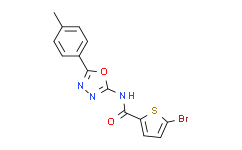| Cas No.: | 952849-76-2 |
| Chemical Name: | KKL-10 |
| Synonyms: | KKL-10;KKL10 |
| SMILES: | O=C(C1=CC=C(Br)S1)NC2=NN=C(C3=CC=C(C)C=C3)O2 |
| Formula: | C14H10BrN3O2S |
| M.Wt: | 364.21710062027 |
| Purity: | >98% |
| Sotrage: | 2 years -20°C Powder, 2 weeks 4°C in DMSO, 6 months -80°C in DMSO |
| Description: | KKL-10 is a small-molecule ribosome rescue inhibitor with broad-spectrum antimicrobial activity against bacteria. |
| In Vitro: | The ribosome rescue inhibitor KKL-10 exhibits exceptional antimicrobial activity against both attenuated and fully virulent strains of F. tularensis. The minimum inhibitory concentration (MIC) against F. tularensis strain LVS and Schu S4 are 0.12 and 0.48 μg/mL, respectively. KKL-10 arrests intracellular growth of F. tularensis during all stages of infection. KKL-10 does not affect macrophage viability or function. KKL-10 produces cytotoxic effects of less than 5% at concentrations up to 17.5 μg/mL. The combination of IFN-γ stimulation and KKL-10 activity results in a reduction of the bacterial load by >99.9%. KKL-10 is also able to inhibit growth of F. tularensis inside eukaryotic cells and show no toxicity to HepG2 cells[1]. |
| References: | [1]. Goralski TD, et al. Inhibitors of Ribosome Rescue Arrest Growth of Francisella tularensis at All Stages of Intracellular Replication. Antimicrob Agents Chemother. 2016 May 23;60(6):3276-82. |

 DC Chemicals' products qualify for U.S. tariff exemptions. We guarantee no price increases due to customs duties and maintain stable supply, continuing to deliver reliable research solutions to our American clients.
DC Chemicals' products qualify for U.S. tariff exemptions. We guarantee no price increases due to customs duties and maintain stable supply, continuing to deliver reliable research solutions to our American clients.





















